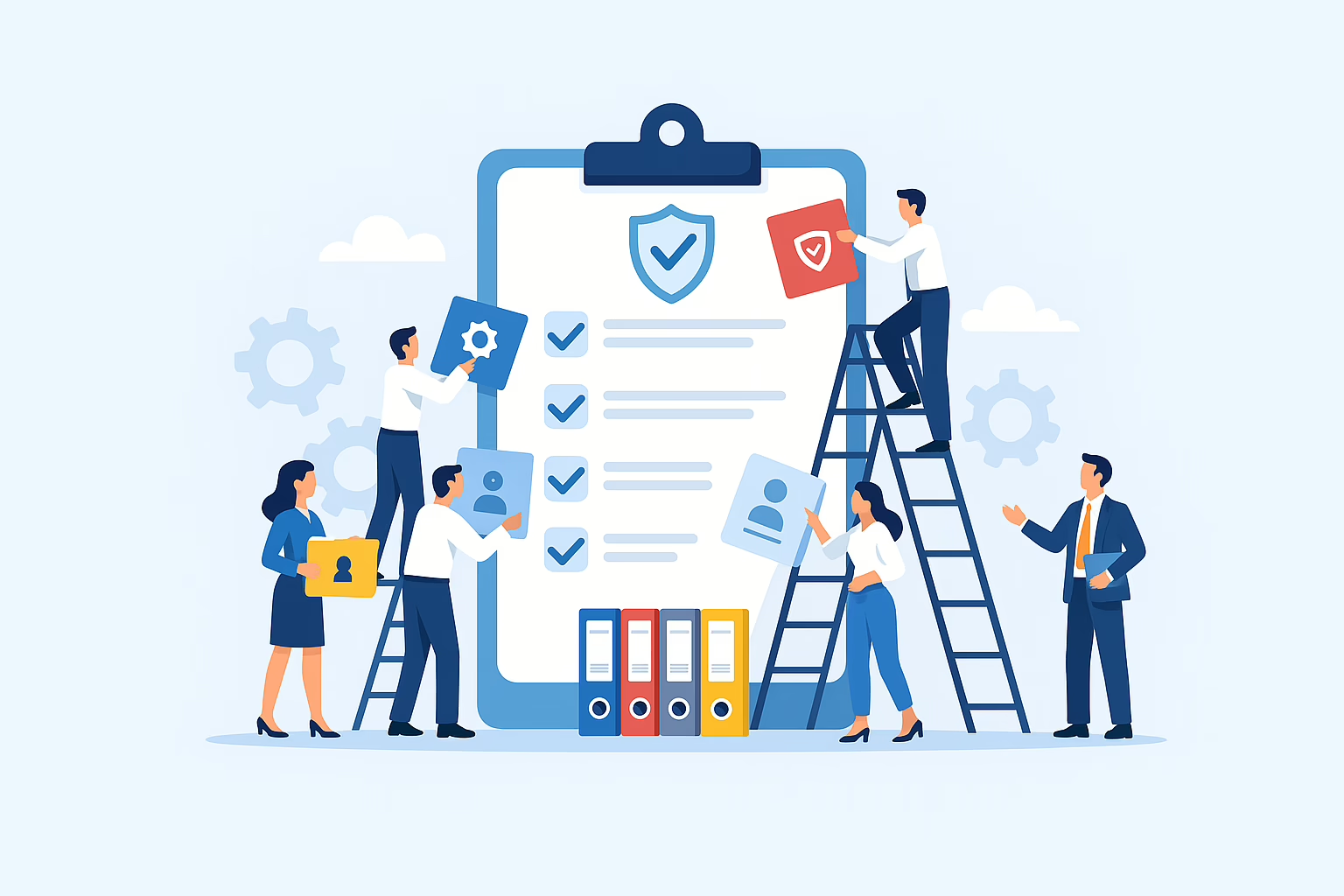The Foundation of Responsible IT Governance
In mid-sized Australian organisations, IT governance is often less mature than leaders assume. Systems are modern, cloud services are in place, and security tools are deployed — yet the foundational governance layer is missing: a complete, current, and defensible suite of IT policy documents. It’s an oversight that leaves Directors exposed and businesses vulnerable.
Policies are not bureaucracy. They are the formal expression of how an organisation intends to manage risk, protect data, and meet its legal and regulatory obligations. Without them, teams operate on assumptions, outdated habits, and tribal knowledge. During an incident, that ambiguity turns into delay; during an audit, it turns into findings.
The surprising reality is that many organisations cannot confidently answer a simple governance question: “Do we have a minimum suite of IT policies, and are they fit for purpose?” In our work with Boards and Executive teams, the answer is often unclear — or worse, a hesitant yes based on policies that no longer reflect current systems or threats.
The Australian Government’s Protective Security Policy Framework (PSPF) and the ACSC Information Security Manual (ISM) provide strong references for what good looks like. They outline the baseline policies every organisation should have, along with the expected structure and content inside them.
This article outlines how to confirm whether your minimum policy suite exists, whether it is defensible, and what steps to take if it isn’t.
Key Takeaways
- Many organisations operate without a complete, defensible suite of IT policies.
- A minimum policy set demonstrates due diligence and reduces governance risk.
- Policies must be relevant, actionable, and aligned to real business processes.
- Frameworks like PSPF and ACSC ISM provide structure and benchmark expectations that should be applied pragmatically to the specific circumstances of each organisation..
- Reviewing policy existence and content is a foundational governance task for Directors.
- Beyond Technology helps organisations identify gaps and develop policy maturity quickly.
Summary Table
| Policy Area | Minimum Expectation | Common Gap | Best Practice |
| Acceptable Use Policy | Clear guidance on what staff can and cannot do with systems | Generic templates not aligned to business operations | Tailor policies to organisational roles, systems, and risk profiles |
| Information Security Policy | Defines controls, roles, responsibilities, and standards | Outdated content; unclear accountability | Align structure and controls with ACSC ISM |
| IT Technical Governance Policy | Confirms delegation rights, governance responsibilities and how technical controls are applied | Informal and undocumented delegation rights that cause confusion in emergencies | Tailored governance responsibilities specific to your organisations structure |
| Data Breach Response Plan | Clear detection, escalation, and reporting steps | No tested or rehearsed response process | Integrate guidance from OAIC, ISO 27001 A.17, and run regular simulations |
Confirming the Existence of Core IT Policy Documents
One of the simplest and most revealing governance questions a Director can ask is also the one most commonly met with hesitation: “Do we have a complete and current suite of IT policies?” For many mid-sized organisations, the honest answer is unclear. Policies often exist in fragments — a template from a past consultant, a half-finished draft in SharePoint, or an outdated PDF no one has read in years. That’s not governance; it’s guesswork.
A defensible IT policy framework starts with establishing the minimum baseline. At a minimum, every organisation should maintain three core policies:
- Acceptable Use Policy – outlining expected staff behaviour and system use
- Information Security Policy – defining controls, responsibilities, and standards
- IT Technical Governance Policy – detailing delegation rights and governance responsibilities
- Data Breach Response Plan – detailing detection, escalation, and reporting steps
These documents form the backbone of operational discipline. Without them, the organisation is exposed during incidents, vulnerable during audits, and directionless when making risk-based decisions.
The Australian Government’s Protective Security Policy Framework (PSPF) provides a strong reference point for establishing this baseline. While designed for government, its principles translate directly to private-sector governance maturity: leadership accountability, clear policy structure, and defined responsibilities.
The first step is verification. Ask your IT lead for a complete list of all current IT policies — not drafts, not assumptions, but the actual documents in circulation. If the list is blank, incomplete, or shows policies with no review dates, you have clarity: the policy suite is not fit for purpose.
Documenting what exists (and what doesn’t) is the foundation for rebuilding governance on solid ground.
Assessing Policy Content for Relevance and Effectiveness
Having policies is one thing; having useful policies is another. Many organisations proudly point to a folder of IT policies, only to discover they are generic templates, years out of date, or completely disconnected from how the business now operates. A policy that doesn’t reflect current systems, roles, or risks provides no protection — it simply becomes shelf-ware.
Effective policies share three characteristics:
- They are specific to the organisation.
They reference the systems actually in use, the way people work, and the real risks faced. - They define accountability.
Roles, responsibilities, and consequences must be unambiguous. A policy with no owner is a policy that will never be followed. - They are actionable.
Policies must provide guidance that is understandable and can be executed — not vague statements of intent.
A practical way to test policy quality is to review content against a recognised framework. The ACSC’s Information Security Manual (ISM) sets a clear benchmark for structure, control categories, and governance expectations. When measured against ISM principles, gaps become obvious: missing control requirements, undefined roles, outdated statements, or entire sections that no longer reflect the operating environment.
This review should start with the IT Technical Governance Policy, because it anchors the entire governance system. If this document is weak, incomplete, or misaligned, every dependent policy inherits the same shortcomings.
Once gaps are identified, remediation should follow quickly. Updating policy content is one of the most cost-effective governance improvements an organisation can make — yet one of the most neglected.
Strong content doesn’t just meet compliance requirements; it builds confidence that policy decisions are defensible when challenged.
Turning Policy into Practice
A well-written policy means nothing if it isn’t understood, applied, and reinforced. One of the most common weaknesses we see in mid-sized organisations is that policies exist on paper, yet decision-making still relies on habit, assumption, or whoever happens to be the loudest voice in the room. Governance only works when policy moves from documents to day-to-day behaviour.
The first step is communication. Policies must be introduced properly — not buried in an onboarding pack or sent as a blanket email. Staff need to know what has changed, why it matters, and what actions are expected of them. When policies clarify accountability, people make better decisions.
Next is operational integration. Policies should guide real processes such as change management, access provisioning, incident response, and risk assessments. If teams can’t point to where a policy influences their workflow, it’s a sign the policy isn’t embedded.
Regular reviews and training are essential. Technology, threats, and business operations evolve; policies must evolve with them. Annual reviews ensure documents remain relevant, while short, targeted training reinforces expectations. Without reinforcement, even the best policies lose their influence over time.
Most importantly, policies need ownership. Someone must be accountable for maintaining each document, coordinating updates, and ensuring the content still reflects reality. This is where many organisations fall short — policies with no owner quickly become outdated.
Turning policy into practice is a cultural shift, not a compliance task. When policies are lived, not just written, organisations build a governance foundation that reduces operational risk and strengthens decision-making at every level.
Beyond Technology’s Governance Advisory Approach
Strengthening IT governance is not simply a documentation exercise — it requires clarity, structure, and a model that can stand up to real-world pressure. This is where Beyond Technology provides meaningful, practical value. Our approach is designed for mid-sized Australian organisations that need defensible governance without unnecessary complexity or bureaucracy.
We begin by establishing visibility. Most organisations are unaware of how incomplete or outdated their policy suite actually is. We conduct a structured review to identify missing documents, unclear ownership, outdated content, and gaps against frameworks such as the PSPF and ACSC ISM. This creates a transparent baseline that leaders can act on immediately.
From there, we help clients build a fit-for-purpose policy framework. Our focus is not on producing thick policy manuals that no one will use, but on creating concise, clear, and actionable documents that reflect the organisation’s real systems, processes, and risks. Each policy is tailored, not templated — and designed to support both operational discipline and audit scrutiny.
Beyond Technology also supports implementation and governance uplift. We define ownership models, update cycles, approval processes, and communication plans so policies remain living documents rather than static PDFs. This ensures that governance matures sustainably, not temporarily.
Finally, we provide ongoing assurance. As environments change, threats evolve, and regulatory expectations increase, we help organisations keep their policies aligned and defensible. This ensures leaders can demonstrate due diligence and governance accountability at any moment.
Our plan is simple: give organisations the confidence that their IT policy framework is complete, current, and capable of supporting both operational resilience and strategic decision-making.
Final Thoughts: IT Policies as Proof of Governance
Strong IT governance doesn’t start with technology — it starts with clarity. A complete, current, and defensible suite of IT policies is one of the simplest indicators of organisational maturity, yet it’s also one of the most frequently overlooked. When policies are missing, outdated, or generic, leaders lose visibility, teams lose direction, and the organisation is left exposed during incidents, audits, and regulatory reviews.
Policies are not there to tick a compliance box. They are there to shape behaviour, inform decisions, and protect the business when something goes wrong. When they are clear and actionable, they reduce ambiguity; when they are updated regularly, they reflect real risks; when they are followed, they become the backbone of a resilient organisation.
Beyond Technology helps organisations move from uncertainty to confidence. With the right governance foundations in place, leaders can demonstrate due diligence, teams can work with clarity, and the business can operate with the assurance that its policy framework is both defensible and aligned to its risk environment.
FAQs Answered
1. What IT policies should every organisation have as a minimum?
Every organisation should maintain at least four core IT governance documents: an Acceptable Use Policy, an IT Technical Governance Policy, an Information Security Policy, and a Data Breach Response Plan. These documents form the foundation of defensible IT governance. They clarify expectations, assign accountability, and provide direction during incidents. Beyond Technology helps organisations confirm whether this minimum suite exists and identify any gaps that need immediate remediation.
2. Why are IT policies important for governance and compliance?
IT policies demonstrate that leaders understand their obligations and have implemented structures to manage risk. Regulators, auditors, and insurers increasingly expect clear, documented policies as proof of due diligence. Without them, organisations face governance gaps, inconsistent decision-making, and unnecessary exposure during incidents. Policies are not paperwork — they are evidence of responsible leadership.
3. How often should IT policies be reviewed or updated?
Policies should be reviewed at least annually, or whenever there is a material change to systems, risks, or regulatory requirements. Many organisations fall behind because ownership is unclear or reviews are not scheduled. Beyond Technology helps establish update cycles, governance processes, and approval workflows so policies remain current and defensible over time.
4. What frameworks can organisations use to improve IT policy quality?
The Australian Government’s Protective Security Policy Framework (PSPF) and the ACSC Information Security Manual (ISM) provide strong references for structure, content, and governance expectations. Using these frameworks ensures policies are comprehensive, risk-aligned, and audit-ready. BT helps organisations tailor these frameworks proportionately to their size and operational complexity.
5. How can leaders tell if their IT policies are outdated or ineffective?
Warning signs include generic content, unclear responsibilities, missing review dates, or policies that no longer reflect current technology environments. If staff cannot explain how a policy affects their workflow, it is likely ineffective. BT conducts structured policy reviews to highlight gaps, remove outdated content, and rebuild documents so they genuinely support governance.
6. How does Beyond Technology help businesses strengthen their IT policy framework?
Beyond Technology provides independent, expert guidance to help organisations build complete, current, and actionable IT policy suites. We assess existing documentation, identify missing or outdated policies, align content to recognised frameworks, and help establish governance processes that keep policies relevant. Our goal is simple: give leaders confidence that their IT governance is defensible, auditable, and fit for the real risk environment.









